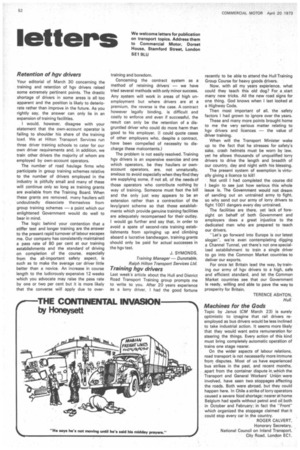Retention of hgv drivers
Page 54

If you've noticed an error in this article please click here to report it so we can fix it.
Your editorial of March 30 concerning the training and retention of hgv drivers raised some extremely pertinent points. The drastic shortage of drivers in some areas is all too apparent and the position is likely to deteriorate rather than improve in the future. As you rightly say, the answer can only lie in an expansion of training facilities.
I would, however, disagree with your statement that the own-account operator is failing to shoulder his share of the training load. We at Hilton Transport Services run three driver training schools to cater for our own driver requirements and, in addition, we train other drivers the majority of whom are employed by own-account operators.
The number of road haulage firms who participate in group training schemes relative to the number of drivers employed in the industry is pitifully small and many of these will continue only so long as training grants are available from the Training Board. When these grants are removed, many hauliers will undoubtedly dissociate themselves from group training schemes — a point which our enlightened Government would do well to bear in mind.
The logic behind your contention that a stiffer test and longer training are the answer to the present rapid turnover of labour escapes me. Our company has consistently maintained a pass rate of 80 per cent at our training establishments and the standard of driving on completion of the course, especially from the all-important safety aspect, is such as to make the average car driver little better than a novice. An increase in course length to the ludicrously expensive 12 weeks which you advocate may raise the pass rate by one or two per cent but it is more likely that the converse will apply due to over
training and boredom.
Concerning the contract system as a method of retaining drivers — we have tried several methods with only minor success. Any system will work in areas of high unemployment but where drivers are at a premium, the reverse is the case. A contract however legally binding, is difficult and costly to enforce and even if successful, the result can only be the retention of a disgruntled driver who could do more harm than good to his employer. (I could quote cases of other employers who, despite a contract, have been compelled of necessity to discharge these malcontents.) The problem is not easily resolved. Training hgv drivers is an expensive exercise and one which operators, be they hauliers or ownaccount operators, are, not unnaturally, anxious to avoid especially when they find they are supplying some, if not all, of the needsof those operators who contribute nothing by way of training. Someone must foot the bill and the only just way appears to be an extension rather than a contraction of the levy/grant scheme so that those establishments which provide genuine training facilities are adequately recompensed for their outlay, I would go further and say that, in order to avoid a spate of second-rate training establishments from springing up and climbing aboard a lucrative bandwagon. training grants should only he paid for actual successes in the hgv test.
J. SYMONDS, Training Manager — Dunstable, Ralph Hilton Transport Services Ltd




































































































